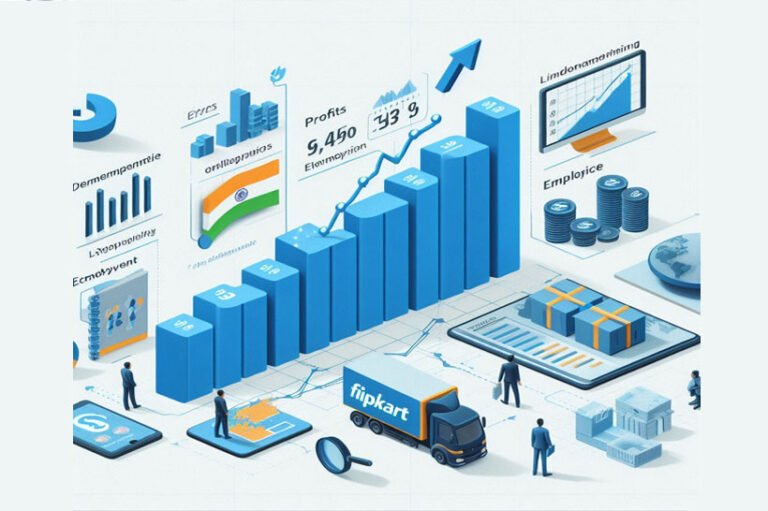Founded in 2007 by Sachin Bansal and Binny Bansal, Flipkart emerged as a pioneer in India’s e-commerce landscape. Initially starting as an online bookstore, it swiftly expanded its product range to include electronics, fashion, and household goods, becoming the go-to destination for millions of Indian consumers. The company’s innovative approach, including features like Cash on Delivery and robust logistics networks, played a pivotal role in its rapid growth. Flipkart’s acquisition by Walmart in 2018 further bolstered its position, providing access to resources and expertise to scale its operations and compete more effectively in the fiercely competitive market against rivals like Amazon India.
Over the years, Flipkart has continued to innovate and diversify its offerings, introducing services like Flipkart Plus loyalty program and investing in technology-driven solutions such as artificial intelligence and machine learning. Additionally, it has ventured into new segments like digital payments and video streaming, aiming to capture a larger share of the Indian consumer’s digital wallet. Despite facing challenges ranging from regulatory hurdles to intense competition, Flipkart remains a dominant force in India’s e-commerce ecosystem, continually striving to enhance customer experience and stay ahead of the curve in a dynamic marketplace.
The History of Technology in Flipkart:
Flipkart’s journey through technological advancements mirrors the rapid evolution of e-commerce itself. From its humble beginnings as an online bookstore in 2007, Flipkart swiftly embraced emerging technologies to enhance user experience and streamline operations. Innovations such as recommendation algorithms, secure payment gateways, and robust logistics management systems have been pivotal in propelling Flipkart to its current status as one of India’s leading e-commerce giants. Through strategic investments in technology, Flipkart has continuously adapted to meet the ever-changing demands of the digital marketplace, marking significant milestones in the history of technological innovation within the company.
Flipkart: The Potential of Artificial Intelligence:
Artificial Intelligence (AI) holds immense promise for Flipkart, revolutionizing various aspects of its operations. From personalized product recommendations to efficient supply chain management, AI algorithms analyze vast amounts of data to optimize every stage of the e-commerce process. Flipkart’s foray into AI-powered chatbots and virtual assistants further showcases its commitment to harnessing technology to enhance customer service and engagement. As AI continues to advance, Flipkart stands poised to leverage its potential to drive innovation, improve efficiency, and elevate the overall shopping experience for millions of users.
Lesson From Aisle One: Supermarkets Are Subject To Change:
The traditional concept of supermarkets is undergoing a profound transformation, with consumer behaviors and technological advancements driving significant shifts in the retail landscape. Aisle One, the heart of every supermarket, now faces competition not only from brick-and-mortar rivals but also from the convenience and accessibility offered by online platforms like Flipkart. Embracing digitization, supermarkets must redefine their strategies to adapt to changing consumer preferences and embrace omnichannel approaches to remain competitive in today’s dynamic marketplace.
How Does the Economy Affect Flipkart?
The economy plays a crucial role in shaping Flipkart’s business dynamics, influencing consumer spending habits, market trends, and regulatory environments. Economic fluctuations, such as inflation rates, currency devaluation, and GDP growth, directly impact purchasing power and consumer sentiment, thereby affecting Flipkart’s sales and revenue. Additionally, macroeconomic factors like government policies, trade agreements, and global economic trends can introduce uncertainties and challenges for Flipkart’s operations, requiring agile adaptation and strategic planning to navigate effectively.
Flipkart and the Economy: The Relationship Explained:
The relationship between Flipkart and the economy is multifaceted, with each exerting influence on the other in a dynamic interplay of forces. As one of India’s largest e-commerce platforms, Flipkart contributes significantly to the country’s economic landscape by generating employment, fostering entrepreneurship, and facilitating trade across various sectors. Conversely, fluctuations in economic indicators, market conditions, and regulatory policies can impact Flipkart’s operations, profitability, and growth trajectory. Understanding this symbiotic relationship is essential for stakeholders to anticipate challenges, capitalize on opportunities, and foster sustainable economic development.
Flipkart Software Helps:
Flipkart’s innovative software solutions play a pivotal role in enhancing operational efficiency, optimizing customer experiences, and driving business growth. From robust e-commerce platforms and intuitive mobile applications to sophisticated data analytics tools and AI-driven algorithms, Flipkart’s software ecosystem empowers users with seamless navigation, personalized recommendations, and secure transactions. By continually investing in software development and technology infrastructure, Flipkart remains at the forefront of digital innovation, delivering unparalleled value to millions of customers and sellers across India.
Flipkart and the Economy FAQs:
How does Flipkart contribute to the economy? Flipkart contributes to the economy by generating employment, fostering entrepreneurship, and facilitating trade across various sectors. Additionally, it stimulates consumer spending and promotes market competition, driving economic growth and development.
What impact do economic fluctuations have on Flipkart? Economic fluctuations, such as inflation rates, currency devaluation, and GDP growth, directly impact consumer spending habits and sentiment, thereby influencing Flipkart’s sales and revenue. Moreover, macroeconomic factors like government policies and global economic trends can introduce uncertainties and challenges for Flipkart’s operations.
How does Flipkart adapt to changes in the economy? Flipkart adapts to changes in the economy through agile business strategies, innovative technology solutions, and proactive market analysis. By closely monitoring economic indicators and consumer trends, Flipkart can anticipate challenges, capitalize on opportunities, and adjust its operations accordingly to maintain competitiveness and sustainable growth.
In conclusion, it’s evident that Flipkart’s success is intricately linked with its ability to navigate the complexities of technology and the economy. As the company continues to innovate and adapt to changing landscapes, its impact on the retail industry and the broader economy will undoubtedly remain profound. By staying agile, investing in cutting-edge technologies, and fostering strong partnerships, Flipkart is poised to shape the future of e-commerce in India and beyond.
More Read:
Geekzilla Podcast 2023: Dynamic Hosts, and Diverse Topics Explored
How to Support Your Child When a Parent Gets a New Partner?
How Geekzilla Tech Redefines Solutions through Integration
I am an experienced financial analyst & writer who is well known for his ability to foretell market trends as well.

